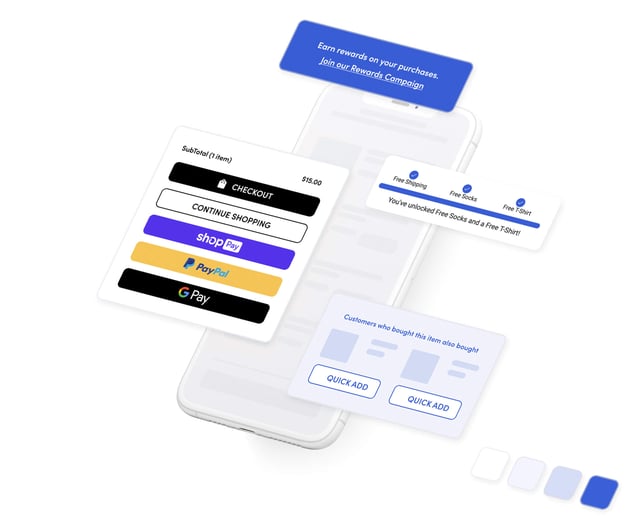Ecommerce Personalization: The Complete Guide for Founders, Merchants, and Marketers
Your ecommerce personalization journey starts here.👇

Crush your goals with revenue optimization strategies like personalized user experiences, proactive customer service, and demand forecasting.
For most challenging ventures in life, people can’t expect to excel just by showing up. They need a plan — a strategy to keep them on track and ready for the tumultuous nature of anything hard to do.
The same goes for an ecommerce business.
Running a successful ecommerce business requires more than just a great product lineup and a functional website. Every decision you make, from how you display products to how you address customer concerns, can directly influence your bottom line.
This is why learning to maximize revenue is a critical part of establishing and sustaining a competitive business.
Throughout this guide, we’ll explore five comprehensive strategies that help ecommerce businesses boost their profitability and maximize revenue. These strategies each play a vital role in helping your store meet its revenue goals while continuing to grow in a sustainable fashion.
The Overarching Data-Driven Strategy
The Personalized User Experience Strategy
The Proactive Customer Service Strategy
The Targeted Marketing Strategy
The Demand Forecasting and Pricing Strategy
The first step in your journey to maximize revenue is establishing a strong data-driven foundation. Without accurate data, you’re left guessing which products resonate most with your audience, which marketing efforts are profitable, and how to best allocate resources.
Data provides clarity and direction, ensuring that every decision is informed by real-world insights rather than assumptions.
By focusing on metrics like acquisition costs, conversion rates, average order value, and churn, you can build a clear picture of your store’s performance.
This evidence-based approach helps you pinpoint where customers drop off, which marketing campaigns work best, and how to optimize your product lineup to encourage more frequent purchases.
Why Data Is Essential
According to a Harvard Business Review survey, data-driven organizations are more profitable than those that don’t prioritize data.
Data serves as the foundation for practically every other revenue optimization strategy. It informs your personalization tactics, shows you where customer service gaps might be, and shines a spotlight on which marketing messages convert.
Without data, you risk prioritizing the wrong areas or neglecting potentially lucrative opportunities.
When it comes to revenue optimization, your data needs to track factors that tell a story about conversion, churn, and customer retention to figure out what’s working and what isn’t.
When you track relevant metrics such as product discovery rates, site engagement, and cart abandonment patterns, you can see exactly which steps lead customers to complete a purchase and which ones push them away.
These data points act like breadcrumbs, guiding you toward an approach that systematically maximizes revenue at every customer touchpoint.
Identifying the Right KPIs
Not all data points carry the same value. To truly maximize revenue, you need to pinpoint the metrics that provide actionable insights.
These usually include user engagement, cost per acquisition, average order value, customer lifetime value, and even advocacy metrics like Net Promoter Score.
When you focus on these key performance indicators, you gain a multidimensional view of how your business is doing.
For instance, a healthy average order value might suggest your cross-selling tactics are effective. Meanwhile, a high repeat purchase rate can indicate strong customer loyalty. Together, these insights help you refine your approach and drive more sustainable revenue growth.
Tools for Gathering Data
There are many tools at your disposal for gathering ecommerce data. Built-in analytics on platforms like Shopify, specialized solutions like Google Analytics - there’s no shortage of ways to quantify customer behavior.
These tools can show you where your buyers come from, which pages they spend the most time on, and where they exit your site.
You can also employ third-party software that uses machine learning algorithms to interpret complex data sets. These solutions collect metrics and help you spot patterns, predict buying behavior, and offer real-time adjustments, helping you continually maximize revenue by aligning your sales approach with the most profitable opportunities.
The Benefits of A/B Testing
With KPIs clearly laid out, you can now start gathering data through various methods, like A/B testing.
A/B testing will help you gather significant data, like which products, layouts, or offers lead to the most conversions.
A/B testing allows you to compare two variations of a particular element - like website layout, product imagery, or checkout flow - to see which version yields higher conversions. This method removes guesswork and lets data drive your design decisions. If Version B outperforms Version A by a significant margin, you have a clear winner.
Through systematic testing, you’ll discover small tweaks that can have a monumental impact on revenue.
Maybe you find that changing a call-to-action color boosts clicks by 10%, or simplifying the checkout process increases conversion rates by 15%, for example.
These incremental improvements add up, helping you maximize revenue one data-driven experiment at a time.
SaaS programs like Rebuy provide A/B testing tools and real-time insights into your customer segments to develop a top-notch merchandising process for every shopper.
Using AI and ML for Deeper Insights
We've touched on them above, but let's take a moment to go deeper into the ways Artificial intelligence (AI) and machine learning (ML) can seriously elevate your ecommerce store’s performance when used correctly.
By analyzing purchase histories, browsing habits, and customer interactions, AI-driven solutions provide hyper-accurate predictions of what your customers want next.
These capabilities allow you to automatically adapt website elements like recommended products or promotional offers to each user’s unique preferences. The result is a smarter store - one that’s constantly learning from each click, view, and purchase.
This intelligent data interpretation is a powerful way to maximize revenue by meeting and exceeding shopper expectations at every turn.
Starting with a data-driven strategy will set you off on the right foot on your journey to optimize revenue. All other strategies will only be better served if you prioritize collecting and analyzing customer data first. The more reliable information you have, the more likely you are to make good data-driven decisions.
Conduct data analysis of these metrics so you can use them to improve your ecommerce business. Today, many artificial intelligence and machine learning programs track customer behavior and sales revenue to provide an accurate story. You can use that information to automatically serve the customer.
According to a Zendesk report, 70% of consumers spend more with companies that personalize the experience.
Once you have a strong data-oriented foundation, it’s time to create personalized experiences that delight your customers.
Personalization is more than just suggesting products they might like; it’s about making each visitor feel understood and valued from the moment they land on your site to the post-purchase follow-up.
By leveraging shopper data and predictive analytics, you can tailor product recommendations, promotional messaging, and even page layouts to match individual preferences.
This approach not only improves the shopping journey but also increases the average order value, boosting your efforts to maximize revenue.
A modern shopping cart, like Rebuy’s Smart Cart™, creates a custom checkout experience for each customer. As your customers add items to their shopping carts, an intelligent cart will make product recommendations based on their choices, their behavior, and their purchase history. This includes cross-selling or upselling relevant products, offering dynamic bundles, and recommending subscription options to save.

Platforms like Rebuy’s Smart Cart™ use AI-driven insights to suggest complementary items, show enticing bundles, and incorporate subscription offers where relevant.
This functionality transforms the cart from a mere storage space into a sophisticated revenue-driving tool. It reduces friction by showing shoppers what they might need before they even realize it. The result is fewer abandoned carts and more opportunities to maximize revenue through well-targeted cross-sells and upsells.
A smooth checkout experience is another way to reduce churn due to abandoned carts or disgruntled customers. Add checkout features or extensions that support the shopper’s goals. Once your customers are ready to complete their purchases, a smart checkout process will make a few final product recommendations based on their entire cart. It will also show them any discount options or promotion reminders that fit with their specific purchase.
With the right checkout system in place, you’ll not only shorten the path to purchase but also keep shoppers engaged until the very last click. This is one of the most direct ways to maximize revenue, as it addresses a common leak in many ecommerce funnels: cart abandonment.
Additionally, give your customers ample payment options and make it easy for them to check out as a guest rather than requiring them to create an account.
Once a shopper hits “Confirm Purchase,” your work isn’t over. The post-purchase phase is a prime opportunity to build long-term loyalty and encourage repeat orders.
Tailored recommendations for future buys and exclusive offers for returning customers all contribute to a positive brand impression.
Post-purchase is yet another opportunity to personalize and delight your customers while driving repeat business and loyalty.
The post-purchase experience should make it easy for customers to see the value of your company and products by using simple reminders such as:
Effective post-purchase tactics might include follow-up emails with product care tips, sneak peeks of upcoming collections, or loyalty program invitations. When you continue the conversation beyond that initial transaction, you reinforce your brand’s value and keep the door open for future sales—all steps that maximize revenue over time.
To streamline and optimize the post-purchase experience, use a software service like Rebuy that uses data to make real-time adjustments that lead to more successful post-purchase engagement.
A smooth checkout experience is another way to reduce churn due to abandoned carts or disgruntled customers. Add checkout features or extensions that support the shopper’s goals. Once your customers are ready to complete their purchases, a smart checkout process will make a few final product recommendations based on their entire cart. It will also show them any discount options or promotion reminders that fit with their specific purchase.
Additionally, give your customers ample payment options and make it easy for them to check out as a guest rather than requiring them to create an account.
Post-purchase is yet another opportunity to personalize and delight your customers while driving repeat business and loyalty. The post-purchase experience should make it easy for customers to see the value of your company and products by using simple reminders such as:
To streamline and optimize the post-purchase experience, use a software service like Rebuy that uses data to make real-time adjustments that lead to more successful post-purchase engagement.
Customer service shouldn’t just be about solving problems by being reactive. You also need to anticipate questions and make relevant suggestions to create a smoother customer journey. In fact, proactive communication from a company can positively change consumer perspectives. According to a Zendesk survey, “81% of consumers say a positive customer service experience increases the likelihood that they will make another purchase.”
Proactive customer service and sales strategies use a mixture of data, social psychology, and empathy to prioritize customer satisfaction. Sales teams should have direct insight into customer behavior or other historical data that helps them anticipate customer needs and questions. Not only will this help reduce shopper frustration, but it also reflects well on your brand.
Preempting your customers' wants and needs is easier than it sounds. Many tools offer solutions for your customers before they even have a problem in the first place:
To further boost sales performance, implement a rewards program to encourage and recognize sales reps who do an outstanding job. Not only is this a good way to reinforce great work, but it’s also good for their morale and can motivate them to continue their stellar performance.
Remember that excellent customer service often leads to stellar word-of-mouth marketing. A satisfied customer who feels genuinely cared for is more inclined to rave about your brand to friends and family, creating new revenue streams you might never have reached otherwise.
A targeted marketing strategy is all about personalizing your marketing campaigns and brand messages for a specific audience. If you attract potential customers with the right offers and messaging, you get one step closer to another sale.
Just like your website and customer service, a targeted marketing strategy is data-driven and personalized. To start, get clarity on who makes up your customer base and group them into cohorts. Marketing segmentation is based on consumer behavior, demographics, and self-reported data. As you dive deeper into the intricacies of the various personas of each cohort, develop consistent branding and messaging that will resonate with each.

This type of precision targeting will help you produce marketing campaigns that draw in your ideal customers at exactly the right time. For example, say you have a customer who has only purchased once from you (and that was six months ago). This isn’t a loyal and consistent customer, but they could benefit from a nudge. Send a personalized message through email or SMS and remind them of what you have to offer. You can even include a reorder landing page to make it quick and easy to order the same or similar products.
Other targeted marketing strategies you should have in your arsenal include:
As long as you take a targeted and personalized approach, you’ll be well on your way to securing another rung in the ladder toward revenue growth.
Demand forecasting, or using data to predict the future demand for consumer goods, is another data-based revenue optimization strategy. When you accurately forecast demand, you can adjust your inventory, revenue streams, and other factors that affect pricing optimization.
There are a few types of demand forecasting: macro-level, micro-level, short-term, and long-term. In general, the process involves:
Once you’ve done that work, you can develop a dynamic pricing strategy that reduces financial risk. For example, when you set flexible prices based on current market demand, you don’t end up with overinflated prices that lead to a decrease in sales and an excess of inventory. Instead, your predictive models can help you automatically set the right price for your products and maintain a healthy inventory.
Your ecommerce personalization journey starts here.👇
The revenue optimization process is just that: a process. It’s always evolving. At some point, you will need to revamp or adjust one of your strategies. Whenever you get together for a new strategy session, schedule time to evaluate how each existing strategy is or isn’t working and how it can be improved.
You might find that you need more bandwidth or team members to accomplish certain tasks. Or you might want to add a new tool to your lineup of helpful ecommerce assistants.
Integrating Rebuy for Revenue Optimization
One powerful tool to help you unify these strategies is Rebuy, which offers AI-driven insights into customer segments, robust A/B testing, and personalized recommendations.
With Rebuy, you can seamlessly connect data-driven insights with your shopping cart, checkout, and post-purchase experiences.
This integration doesn’t just simplify your workflow; it systematically maximizes revenue. By leveraging Rebuy’s machine learning algorithms, you can automatically highlight complementary products, dynamically adjust pricing strategies, and provide proactive customer service triggers based on shopper behavior—ensuring each step of the customer journey is optimized to drive profitability.
Conclusion and Next Steps
Maximizing revenue is a continuous cycle of collecting data, experimenting, analyzing results, and refining your strategies.
Whether you’re focusing on personalization, proactive customer service, targeted marketing, demand forecasting, or all of the above, a constant willingness to learn and adapt keeps you ahead of the competition.
Implementing these five key revenue optimization strategies and leveraging solutions like Rebuy will help boost your ecommerce business from surviving to truly thriving.
The power to maximize revenue embrace data-driven decisions, keep the customer experience front and center, and watch your profits climb in a sustainable, scalable way.
Interested in partnering with Rebuy? Let's do it.
To keep up with the latest trends, platform updates, and more, follow us on LinkedIn.
Master the art of the Shopify ecommerce checkout flow to create a seamless process from cart to confirmation.
Web 1.0 shopping carts are too outdated for today's shopper. Learn why it's so important to update to a modern cart like the Rebuy Smart Cart™.
Maximize your Shopify sales with cross-selling! Discover why you should cross-sell and learn effective techniques to boost AOV for your Shopify store.
Stay up to date with all things Rebuy by signing up for our newsletter.